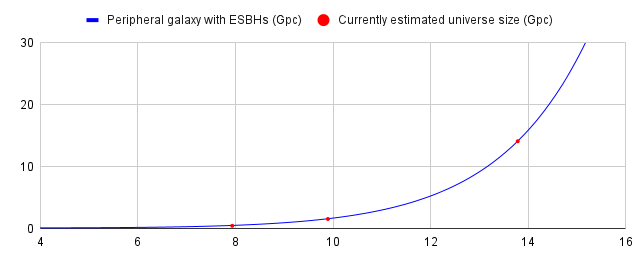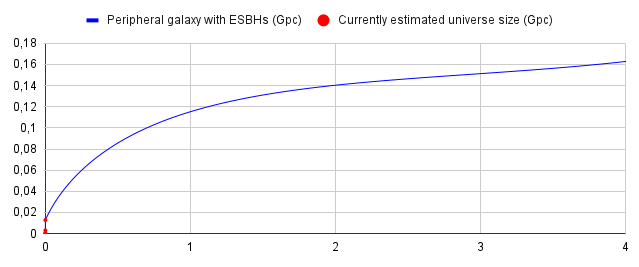Could dark energy simply be multiple (far) black holes, quadrillions of years old?
I’ve always been interested in astrophysics, and I’ve had a question that I can’t stop thinking about for the past years. I would like someone to help me understand what I’m missing, because I couldn’t find anything about it, and couldn’t find anything against it (without a counterargument).
The idea is simply stated: could dark energy simply be multiple far eon-spanning black holes, more than quadrillions, octillions, googols of years old?
Here’s some explanations / details:
Firstly, this doesn’t change anything that we currently agree on: the Big Bang and its age, the effects of dark energy, gravity, etc. It just adds on top, explaining dark energy with nothing more than what we know.
Here are some assumptions that make the idea (possibly) work:
- The full universe is infinite, or much bigger than the known and observable universe (let’s not debate that, we don’t know)
- The universe is much, much older than 13,8 billion years old.
- (The big bang is not the start of it)
- The idea doesn’t take into account how it all started, it’s irrelevant and out of scope.
- As stated above, the Big Bang is not the start of the universe. So it's not the universe. It's just a small part of it: there's more matter around it that was already there.
If the big bang isn’t the beginning of the universe, what is it?
As a preamble, I’ll just mention my current understanding of how stars of different sizes die differently:
- Low-Mass Stars die by swelling and radiate mass, finishing in a small white dwarf.
- Higher-Mass Stars die faster with a supernova, finishing in a black hole.
- The bigger the star, the bigger the black hole.
Black holes then radiate their mass:
- Hawking radiation estimates the evaporation of a black hole in the order of magnitude of one googol years (depending on the mass of the black hole, can be longer or much shorter, relatively).
So here comes the beginning of the universe:
- Small black holes slowly die by radiating mass
- Higher-mass black holes will engulf everything around them, increasing in mass until they have galaxy-scale mass.
- They’re called supermassive black holes, usually in the center of galaxies.
- They take billions of years to form.
- Higher-mass black holes will engulf galaxy clusters, increasing in mass until they have universe-scale mass.
- We didn’t really observe any. We only see mega galaxy clusters like the Hercules–Corona Borealis Great Wall, that might at some point become a bigger black hole containing multiple galaxies from that.
- They probably take trillions, quadrillions, quintillions … (or much more) years to form.
- And these black holes … let’s call them Eon-Spanning Black Holes (ESBH), because “supermassive” is taken (There’s also some people using the term ultramassive blackholes with more than 5 billion solar masses (M☉))
- But what I’m talking about here is a blackhole with the order of magnitude of the mass of the currently known universe. That’s probably (from what we know) … sextillions of M☉.
I don’t know if you’re seeing where I’m going, but I said that bigger stars make explosions. So what I’m suggesting is that “the big bang” is actually an ESBH that exploded (like a supernova for big stars exploding, an ESBH exploding would be a big bang).
It went so massive, and so small, that it couldn’t contain itself. Physics “broke” (figuratively) and created the universe as we know it.
So the idea is that our big bang is actually not “the big bang”, but “a big bang”.
And the scale of time is humongous, titanic, unimaginable. Perhaps in googols of years?
13,8 billion years is not even noticeable in the lifetime of such a humongous black hole.
The big picture
In the grand scheme of things, there would be an infinite collection of ESBHs, with the occasional “big bang” of one of the ESBH, resulting in a blip of chaos, absorbed by all ESBHs eventually, or forming another one, in just a few octillions of years (perhaps more, I don’t know about the time scale).
Dark Energy
Here’s my simplified understanding of dark energy: After our big bang exploded, it began slowing down, due to the mass of what the explosion contained, pulling itself back together. We initially naively thought that it would continue slowing down, and possibly even come back collapsing on itself, “the big crunch”.
The big crunch is no longer plausible, because of “dark energy” (that’s how we call it, because we don’t know what it is), that makes the universe expand again, after it slowed down from its initial explosion velocity.
The infinite collection of ESBHs described above explains the dark energy, being what we call gravity on ESBH scales.
The current universe is around 28.5 gigaparsecs (Gpc) in circumference.
Let’s say that the average distance between all ESBHs is around 700 Gpc.
That would mean there’s a bunch of ESBHs pulling everything from “our big bang” towards them.
At first, even a black hole of 10 sextillions of M☉ wouldn’t have much pull from 700 Gpc. Also considering that there are ESBHs all around, so they’re pretty much all negating each other (as they were all in equilibrium before the big bang).
From the current observations we made, it looks like at around 8-10 billions years old, the big bang’s size expansion started accelerating. From maybe around 3 Gpc in circumference.
At 697 Gpc, ESBHs could start to gradually have a non-negligible pull, accelerating with time. Also, the pull from the other ESBHs on the other side would now be from 703 Gpc, not 700, so that’s an additive effect towards the expansion of the Big Bang, adding to the fact that the peripheral galaxies would be less pulled from the big bang’s mass, the further away from its center it would be.
1D Estimation
I made a quick 1D estimation to see if it would make sense, and even though it’s a gross simplification, it seems like it could be possible.
Here’s 2 graphs (one for the first 4 billion years and another for the rest), followed by more details.
 |
Using the variables in the (green) table. 
Results in the (blue) graph: with a big bang starting at position 0, a peripheral galaxy (meaning: its position is the radius of the universe) moving at 1c after 370000 years (using current estimates), then slowing down due to the mass of the other matter from the Big Bang, and then accelerated by 2 ESBHs located at 700 Gpc on both sides, I get 0,56 Gpc at 8 billion years old, 1,64 Gpc at 8 billion years old, and 14,15 Gpc at 13,78 billion years old, which is close to the agreed upon sizes of around 1,5 Gpc between 8 and 10 billion years, and 14,13 Gpc now (~13,78 billions year)
Conclusion
I feel like it’s possible? I don’t know if it’s probable, so that’s why I’m asking. Any insights?

